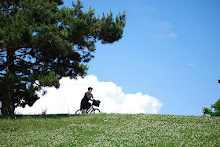Rain and Snow Riding Maintenance
30 Nov 2009
Some of us really ride in any weather which means that we do a lot more maintenance to keep the bicycle on the road and reliable. There is nothing like having to do maintenance/repair when it's below freezing and miles from home. This experience(s) will cure you from maintenance laziness! Hopefully, you will do this to yourself only once.
Before going out, check these items:
1.Saddle height. Since you're probably wearing a lot more clothes, your bottom will have more layers which will make it necessary to lower the height of your saddle. Lowering your saddle will also make it easier to put your feet down when you go into a slide in order to keep yourself upright when you hit those ruts and ice slicks.
2.Chain. Check your chain to make sure it's well lubricated since water and road salt will cause deterioration very quickly if not constantly cleaned and lubed.
3.Brakes. Check that the brakes are working smoothly. In wet weather, brake cables will become corroded pretty quickly. This means that they'll need more maintenance. When they start being harder to pull or have a delay in action, it's time to do maintenance by pulling the inner cable out of the housing, checking for breaks in the cable strands (and bends or breaks in the housing) and if it looks alright, lubing them with a light grease or teflon oil.
4.Shifters/derailleurs. Check that front and rear derailleur are functioning properly. These cables too will need much more maintenance in wet/salty weather.
5.Tire pressure. Check pressure before every ride. Bicycle tubes and tires are not airtight and will lose pressure pretty quickly. For riding on snow and ice, you will want to drop the tire pressure so that the amount of rubber contacting the road is greater. Do not drop the pressure below the minimum listed on the sidewall of the tire or you will get “snake-bite” punctures. If you're riding on very snow-packed or icy roads, consider using spiked tires. They are will worth the investment.
6.Splash-guards. If you have cables that are routed under the down-tube (not usually found on true mountain bikes), are not covered with a housing, but are just bare cables, consider using splash guards to repel some of the water and salt. Splash-guards will also keep some of slop off you if you're not using fenders.
7.Brake lever covers. In very cold weather, brake lever covers will keep your hands much warmer by repelling the wind that sucks the heat out of your hands (even with lobster gloves) quickly.
After you return doing those cold, frigid k's, don't just dump the bike in the garage. It will rust. Clean it up immediately. With this kind of riding, detailing is very important. Make sure you get the water and salt residue out of everything. Rub it down like it's a high-dollar race horse. It takes care of you. You take care of it. Clean the chain every time you ride because the salt and grit gets into the rollers and causes rapid wear and rusting. Once again, check the operation of the brakes and shifters. Re-lubricate every moving part; brake levers, brakes, shift levers (depending upon type), front and rear derailleur and chain. It is during this post-ride routine where you frequently will pick up on mechanical problems that you didn't even notice during the ride.
I recommend a “wet” lubricant for extreme riding conditions. Many of them are synthetic lubricants engineered for long distance riding and wet weather conditions.
Happy riding!
Subscribe to:
Post Comments (Atom)


No comments:
Post a Comment